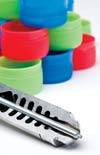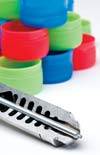Hot Runner Justification
How OEMs, molders and moldmakers can better determine when it makes sense to use hot runner technology.
Competitiveness and price pressure in the injection molding industry has influenced many OEMs, molders and mold manufacturers to look for new ways to survive and thrive in their regional and global markets. At the same time, the basic operational costs related to resin, energy, manpower and overhead continue to creep up year-after-year, putting more strain on profitability. These combined factors make hot runners a more attractive solution compared to cold runners than ever before.
The Economics
For medium and large molded part volumes, the choice to use a hot runner has been obvious. But once the volumes became smaller and the molding application became more challenging, the hot runner versus cold runner decision became more difficult.
To make a fair, unbiased value-based economic assessment, one needs to look at the total cost—assessing both capital and operational cost factors for both the hot and cold runner options. (An alternative to the traditional method of justifying the tool purchase is an electronic hot runner justification tool—e.g., http://hotrunnertool.moldmasters.com).
For instance, injection molding cycle times are typically driven by the cooling time of the thickest section of the part or the runner. In the case of a hot runner, there is no runner to be cooled, so the maximum wall thickness in the molded part is the key influencing factor. However, in the case of cold runners, the runner sizes are typically larger than the maximum part thickness, so the cycle time is lengthened accordingly.
The molding cycles with cold runners can typically be 50 to 100 percent longer than hot runners depending on the size of the runner and the part being molded. These extended cycle times result in an increased piece part cost due to the higher accrual of overheads, manpower and capital costs.
Further affecting the economics are the higher resin and energy costs from molding with cold runners. To help manage resin costs, the scrap cold runners are usually ground and blended back into the molded parts. Practical regrind limits are 15 percent with the remaining scrap runners being sold for pennies per pound or being sent to the landfill. Beyond the resin cost, there are also additional energy dollars spent on drying, heating, cooling and regrinding the wasted cold runners.
These combined economic factors can easily result in the piece part cost from a cold runner being more than twice the cost of the same part made with a hot runner. So from an economic total cost perspective, it is quickly evident that the lower hot runner operational costs can quickly overcome the associated higher capital cost, making hot runners the more attractive choice compared to a cold runner (Figure 1).
Beyond the cost perspective, the resulting higher productivity yields for hot runners will speed the ability for molders to earn profits sooner, and free up injection press time for other production runs.
Molded Part Performance
Cold runners typically generate more shear in the molten resin causing imbalance and higher fill pressures. The extra shear in the resin from molding with cold runners can cause undesirable effects in the molded part, affecting part strength, hinge performance and gate quality. These higher pressures create a greater chance for mold core shift on long cores, resulting in part weight and wall thickness variations. These variations can lead to downstream molded part failures and product liabilities.
Higher fill pressures attributable to cold runners can also create more wear and tear on the injection molding machine with maintenance implications and higher energy consumption rates.
During prototyping, by using a single cavity hot runner tool more representative part performance characteristics and cycle time expectations will be achieved.
Hot Runner Technology
Advances in hot runner technology have expanded the range of possible applications from micro-sized nozzles for inside gating and tight pitch applications, to the other end of the spectrum of very large automotive parts and shipping containers. And unlike cold-runners of the past, hot runners are ideally suited to shear sensitive resins.
Further optimizations in flow and thermal characteristics allow for more balanced fill and faster injection fill rates.
Additional developments in hot runner technology include more sophisticated multi-material applications for many personal care applications, as well as reliable edge gating technology that is favorable for long, thin, medical syringe-type applications.
Reaping the Benefits
Hot runners are a win-win scenario for all.Molders benefit from faster cycles, less wasted resin, reduced energy and a higher productivity solution. The OEM benefits from improved molded part quality and uniformity with reduced risk of molded part failure. This will help to maintain brand image quality and consistency for the OEM. For moldmakers, the use of a quality hot runner with their tool will improve the contributions to the overall value chain through higher productivity yields from their molds.
Related Content
Hands-on Workshop Teaches Mold Maintenance Process
Intensive workshop teaches the process of mold maintenance to help put an end to the firefighting culture of many toolrooms.
Read MoreLaser Welding Versus Micro Welding
The latest battle in finely detailed restoration/repair of mold materials.
Read MoreHow to Eliminate Chatter
Here are techniques commonly used to combat chatter and guidelines to establish a foundation for optimizing the moldmaking process.
Read MoreFundamentals of Designing the Optimal Cooling System
The right mold components can help improve mold cooling and thereby produce higher-quality parts.
Read MoreRead Next
Trends in Hot Runner Technology
Quality, performance, maintenance and flexibility are driving today’s hot runner technology.
Read MoreHow to Use Continuing Education to Remain Competitive in Moldmaking
Continued training helps moldmakers make tooling decisions and properly use the latest cutting tool to efficiently machine high-quality molds.
Read MoreHow to Use Strategic Planning Tools, Data to Manage the Human Side of Business
Q&A with Marion Wells, MMT EAB member and founder of Human Asset Management.
Read More





















